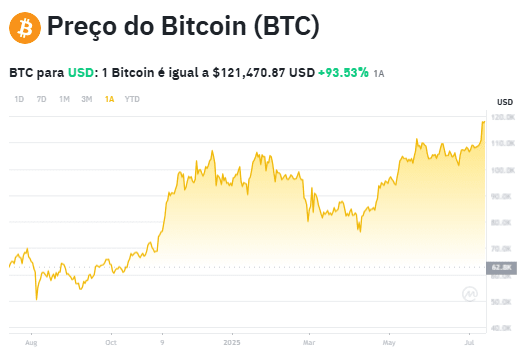Bitcoin has proven, more than once, that underestimating it is a common mistake. After going through impressive appreciation cycles — and equally remarkable drops — the leading cryptocurrency in the market returns to the spotlight with a new wave of optimism.
This time, it is not just speculation. There are concrete factors aligning to create an extremely favorable scenario for Bitcoin, to the point that many analysts and investors believe that the mark of $150,000 could be reached in the near future.
In this article, we gathered the five main reasons behind this expectation. If you invest in crypto or are considering entering the market, it is worth paying attention.
1. 2024 Halving: less supply, more value
Halving is a scheduled event that halves the reward paid to Bitcoin miners for each validated block. This happens every four years and has a direct impact on the currency's issuance — meaning fewer new bitcoins enter circulation.
The last halving occurred in April 2024, and history shows that after this type of event, the market tends to react with strong rises in the following months. With reduced supply and demand remaining (or growing), the economic logic is simple: the price tends to rise.
Moreover, the halving also tends to attract media and public attention, which further contributes to the increase in interest and appreciation.
2. Bitcoin ETFs: massive inflow of institutional capital
The approval of Bitcoin ETFs in the United States, which occurred in early 2024, represented a milestone for the market. These funds allow institutional investors — such as pension funds, banks, and large asset managers — to gain exposure to BTC without needing to operate directly with digital wallets or exchanges.
In practice, this has opened the doors to a new flow of capital in the market, with billions of dollars entering in a structured and regular manner. This institutional demand not only provides more liquidity to Bitcoin but also helps further legitimize its role as a global investment asset.
3. Scarcity has never been more real
As the demand for Bitcoin increases, the available supply for trading decreases. This happens for several reasons:
Many investors keep their BTCs in cold wallets, with no intention of selling;
Companies buy and hold large quantities as a store of value;
The structure of Bitcoin itself limits its issuance to 21 million units, and more than 19 million have already been mined.
With fewer BTCs available on exchanges and more people seeking exposure to the asset, the buying pressure tends to outweigh the selling pressure — which usually leads to significant price increases.
4. The macroeconomic scenario favors scarce assets
The world continues to face economic challenges: persistent inflation in various regions, high interest rates, and uncertainties regarding the monetary policy of developed countries.
In this context, Bitcoin gains relevance due to its limited and digital nature. Just as gold is sought as protection against the loss of purchasing power, BTC has been considered a modern hedge alternative — especially among younger or more tech-savvy investors.
Moreover, in times of geopolitical tension or banking instability, Bitcoin is often seen as an alternative that escapes centralized control and offers more financial autonomy.
5. Real adoption in emerging countries
A silent but extremely powerful movement is the growth of Bitcoin usage in countries with unstable economies, fragile currencies, or banking restrictions. Regions such as Latin America, Southeast Asia, and parts of Africa have been adopting BTC as a means of protection against inflation and as a tool for financial inclusion.
Additionally, solutions like Binance Pay — which allow payments with cryptocurrencies in a simple manner integrated with local systems, such as Pix in Brazil — make practical use of Bitcoin increasingly viable in everyday life.
This real and organic adoption reinforces the value of the asset not only as a reserve but as a useful and accessible tool.
Ignoring Bitcoin now could be costly
The cryptocurrency market is indeed volatile. But when we look at the fundamentals that today support Bitcoin — programmed scarcity, growth of institutional demand, global economic scenario, and increasing adoption — it is hard not to see a clear potential for appreciation.
The mark of $150,000 may seem distant for some, but with the right factors in play, BTC has already shown that it can exceed expectations. And for those who understand market timing, missing this movement could mean passing up one of the biggest opportunities of this decade.

The above chart shows exactly this movement: an appreciation of approximately 90% over the period of one year. Bitcoin rose from the range of $57,000 and is now priced above $118,000. This increase reflects the combination of factors discussed in this article — such as the 2024 halving, massive inflow of institutional capital, and growing adoption in emerging countries — and reinforces the expectation that new price records may be on the horizon.
If you are paying attention to the transformations in the investment world, Bitcoin remains an asset that deserves to be on the radar.
#BTCBreaksATH #BTC #bitcoin #BTC☀ #BTC120kVs125kToday
---
Photo available on Freepik